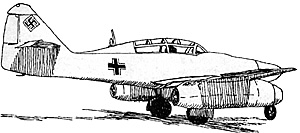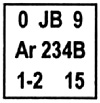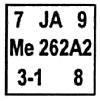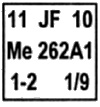
As is often the case in Europa OB research I've come across some new information that necessitates some changes in the appearance of the German jets.
Kampfgeschwader 76 was the only user of the bomber version of the Ar 234, but it only managed to get one Gruppe and an additional staffel operational before the Germans demolished the factory building it in March in the face of the Soviet advance. To properly reflect this delete both Ar 234Bs in Nov 144 in the West and replace them with one in Jan 145.
The single Ar 234s that appear in both the West and Greater Germany Tac Air in May are a little more problematic. The Ar 234 was almost unique in that only a single factory produced it. If it isn't overrun then the Germans would have undoubtedly finished equipping II/KG 76 and might have even been able to equip I/KG 76 as well.
 There is an additional problem associated with the Ar 234B in
that it was tested with a maximum bombload of 3300 lbs (1500 kg). It
was rated at two-thirds of that to be on the conservative side. However
it is now known that no Ar 234 carried more than 1100 lbs (500 kg) on
any operational mission. Therefore its bombing factors should be a 1-2,
not a 2-4.
There is an additional problem associated with the Ar 234B in
that it was tested with a maximum bombload of 3300 lbs (1500 kg). It
was rated at two-thirds of that to be on the conservative side. However
it is now known that no Ar 234 carried more than 1100 lbs (500 kg) on
any operational mission. Therefore its bombing factors should be a 1-2,
not a 2-4.
The treatment of the Me 262 is also not without its problems. The attack version was first in action over Normandy in staffel strength by late July, but I've not been able to determine when the other staffeln became operational. However I/KG 51 finally united in September and this seems as good a date as any to show the arrival of the Me 262A2. II/KG 51 becomes operational in December on the jet, but I'd delay this to January over doubts about whether the numbers of jets with each Gruppe actually justify two counters. Quite annoyingly, the unit history is silent on these sorts of fine details.
 The chaotic situation in the final stages of the war makes
information about any further jet fighter-bomber units almost
impossible to verify. A large number of former bomber units were to
convert to the 262, but my impression is that they were to be used as
fighters, not fighter-bombers. KG(J) 6 had a few jets in April, but I
don't know what their role was to be since they didn't intercept any
bombers in the short period they had those planes. At any rate adding
one more in May doesn't seem to be pushing things to extremes.
The chaotic situation in the final stages of the war makes
information about any further jet fighter-bomber units almost
impossible to verify. A large number of former bomber units were to
convert to the 262, but my impression is that they were to be used as
fighters, not fighter-bombers. KG(J) 6 had a few jets in April, but I
don't know what their role was to be since they didn't intercept any
bombers in the short period they had those planes. At any rate adding
one more in May doesn't seem to be pushing things to extremes.
To summarize my recommendations, change the November arrival in the West to September and add another in January. Transfer both in March to Greater Germany Tac Air. Change the May arrival to Greater Germany Tac Air from West Tac Air.
 I was way too generous with counters for the Me 262A1
fighters. I can only plead confusion brought on by the large number of
units that actually operated the fighter, although many had only a few
aircraft or never became operational. However a spate of recent books
had greatly clarified the situation for most of these units.
I was way too generous with counters for the Me 262A1
fighters. I can only plead confusion brought on by the large number of
units that actually operated the fighter, although many had only a few
aircraft or never became operational. However a spate of recent books
had greatly clarified the situation for most of these units.
The first kill by the Me 262 fighter was a Mosquito by an aircraft from Erprobungskommando (Operational Testing and Evaluation Unit) Thierfelder in late July 44. This unit was mainly involved in clearing the 262 for service use, but it did shoot down a few aircraft. After the loss of several commanders and an influx of pilots from ZG 26 and KG I this became III/JG 7.
However it wasn't operational until mid-February as it suffered from shortages of aircraft, poorly trained pilots, and poor quality control on the jets that it did receive (as did all the jet units). I/JG 7, converted from the fighter pilots of II/JG 3 and I/KG(J) 54, from bomber pilots, also became operational about the same time. Aircraft were also received in some numbers by 11, III/KG(J) 54, II/JG 7 and Jagerverband 44, but none of these became fully operational. This last unit was commanded by Adolf Galland and may well have had the highest ratio of kills to pilots of any combat unit ever assembled.
However it mustered slightly over a dozen aircraft until the very end when it received aircraft from other units and has been folded into the existing units to help justify their counters. I originally gave a counter for each unit as it formed, but this is far too generous and must be reduced to better match history.
It's easiest to delete all mention of the Me 262A1 in all theaters from the current OB and replace them with 3 in March in Strat Air with another 3 in May, also in Strat Air.
 The only Allied jet fighter also has some problems as far as I'm
concerned. The RAF's 616 Squadron did receive the Meteor I in early
July '44 and was almost immediately flying anti-buzz bomb missions.
However it was also plagued by the inevitable technical problems and I
doubt that it ever had more than the standard 18 aircraft establishment
which is less than half a counter for the RAF. And what about the
conversion time necessary to teach pilots unfamiliar with the type? I'm
willing to bet that it was problems like these that delayed the Meteor's
deployment to the Continent in February after delivery of the first
Meteor 3s as well as the Meteor 1's inferiority to the late-model German
fighters rather than any fear of compromising its secrets that kept them
at home. It's not like the Germans didn't already have jet aircraft already
in service or anything.
The only Allied jet fighter also has some problems as far as I'm
concerned. The RAF's 616 Squadron did receive the Meteor I in early
July '44 and was almost immediately flying anti-buzz bomb missions.
However it was also plagued by the inevitable technical problems and I
doubt that it ever had more than the standard 18 aircraft establishment
which is less than half a counter for the RAF. And what about the
conversion time necessary to teach pilots unfamiliar with the type? I'm
willing to bet that it was problems like these that delayed the Meteor's
deployment to the Continent in February after delivery of the first
Meteor 3s as well as the Meteor 1's inferiority to the late-model German
fighters rather than any fear of compromising its secrets that kept them
at home. It's not like the Germans didn't already have jet aircraft already
in service or anything.
Generally we account for serviceability only in the ARP rate, but I believe that it has a bearing for these cutting-edge aircraft when small numbers are involved. Given that the Meteor 1s numbered less than half a counter and undoubtedly had severe serviceability problems I find David Hughes's decision to include them unreasonable. Similar logic for the Me 262 would advance their arrival dates by 4 months or so which I can't justify since the unit concerned could only muster under half a dozen jets for any given mission and only owned a dozen or so at that time, despite a number of kills by those very few jets.
Now the arrival of the Meteor 3 in May is perfectly fine since 504 Squadron had gotten theirs in April. Granted that 504 probably wasn't quite up to snuff by May, but that's only a small gift in comparison to the current treatment.
-
Introduction
Gunfire from the Wine-Dark Sea
Do Frog Legs Taste Better than Crow?
Old Johann Heinrich was an Eisenbahn Mann
Heavy Transports
The Jets Revisited
Back to Europa Number 56 Table of Contents
Back to Europa List of Issues
Back to MagWeb Master Magazine List
© Copyright 1997 by GR/D
This article appears in MagWeb (Magazine Web) on the Internet World Wide Web. Other military history articles and gaming articles are available at http://www.magweb.com